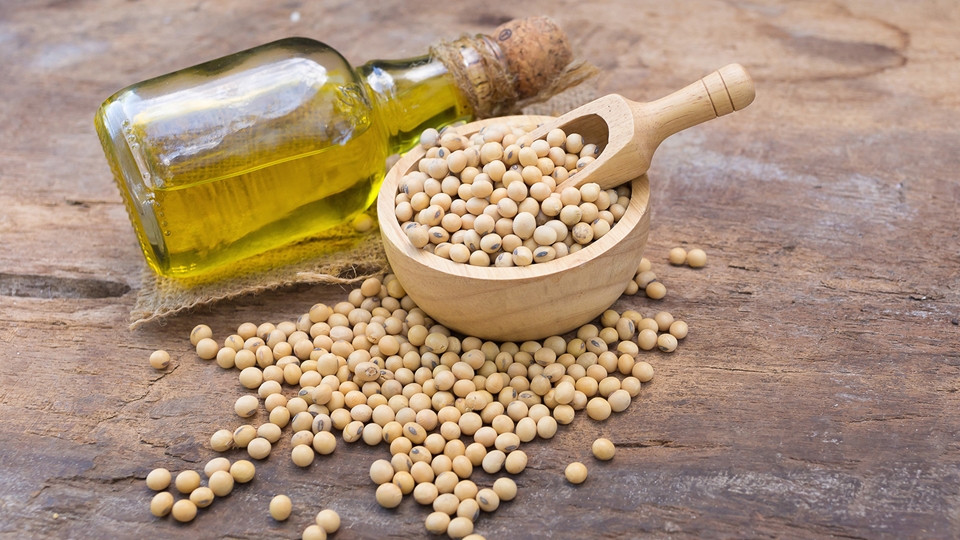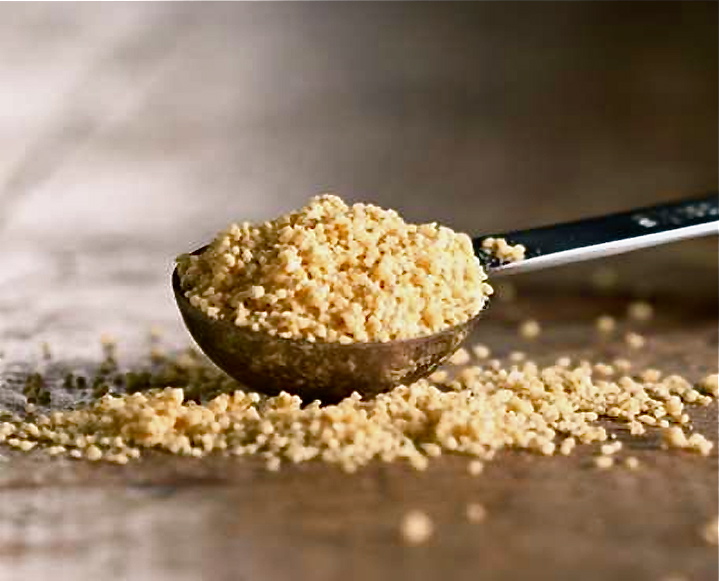Summary of lecithin production process
Crude soybean oil contains an average of 1.8% (range 1.2-3.2%) of hydratable phosphatide. Degumming is a process of removing phosphatide from soybean oil. On the other hand, low-quality soybean oil contains a large amount of free fatty acid and a large amount of non-hydrophilic phosphatide, which is not a suitable source for lecithin extraction. Besides the production of lecithin, another advantage of separating phosphatides from oil is increasing the quality and shelf life of the oil. Lecithin is obtained in the process of degumming crude soybean oil. In the production process, approximately 1% live steam or hot water is added to crude soybean oil at a temperature of about 70 degrees Celsius. Then the emulsion is stirred for 10 to 60 minutes until the phospholipids are hydrated and agglomerated and form a heavy phase insoluble in oil, which is separated from the oil using a centrifuge. Usually with hydrogen peroxide, the process of improving its color from brown or beige to bright yellow is done. Fluidizing additives can then be added to reduce the viscosity of the lecithin to prevent the final product from becoming solid. Finally, with drying systems, the moisture of the product will be reduced to about 1%.
Soybeans are the most important source of commercial lecithin, and lecithin is the most important byproduct of the soybean oil processing industry due to its many uses in food and non-food industrial products. The three main phospholipids in commercial soy lecithin are phosphatidylcholine, phosphatidylethanolamine (commonly called cephalin), and phosphatidylinositols (also called inositol phosphatide). Commercial soy lecithin also typically contains about 35 to 40 percent soybean oil. In fact, lecithin is one of the most complex and versatile substances derived from soy. Phosphatidylcholine is also used to detect pure or chemical lecithin.
Global lecithin market
The lecithin market is one of the emerging markets. The global soy lecithin market is projected to grow from USD 536.18 million in 2021 to USD 740.62 million in 2028. Lecithin manufacturers compete on price due to price sensitive buyers. To gain a competitive advantage in the market, manufacturers emphasize process innovation and low-cost raw material sourcing. In addition, the rapid growth of end-user industries such as food, beverage and pharmaceuticals, in contrast to the increased production of lecithin, is filling the gap between supply and demand, and prices are expected to increase moderately over the coming years. Soy has the largest revenue share in the global lecithin market compared to other sources of lecithin production with more than 79% in 2021 and has taken the first place in this market. This is attributed to the existence of vast areas of land under cultivation and production of soybeans and the growth of the food industry in the regions of Europe, Asia and the Pacific. Applications are mainly used to produce dairy products, ice cream, nutritional supplements, infant formula, bread, margarine and other instant and ready foods. The liquid form of lecithin held the first place in the lecithin market with the largest revenue share of more than 86% in 2021. This high share is due to the sharp increase in demand for liquid form from various end-use industries, such as industrial coatings, cosmetics, food industry. Demand in the North American region is driven by the presence of key end users and easy access to raw materials. The presence of large soybean fields in the United States and rapeseed fields in Canada has increased the growth of the market in this region. Europe dominated the lecithin market with the highest revenue share of more than 30% in 2021. This is attributed to the existence of a significant number of lecithin producers in the region. In addition, abundant raw materials and increased health awareness among consumers in the region will increase demand. India and China are also leaders in this market in Asia. Lecithin in the market is divided into four food grades, animal feed, pharmaceutical and industrial, which differ from each other in terms of price value. The largest share of lecithin consumption in the world with more than 60% belongs to the food and beverage industry, followed by animal feed, followed by pharmaceutical and industrial uses, and the last rank is related to food supplements. Although sunflower and canola lecithins are available on the market, the main commercial interest is in soy lecithin.
Functional characteristics
Emulsify:
Allows immiscible materials to be mixed, especially in water-in-oil systems (such as margarine and chocolate). This is the most widespread use of lecithin.
Dissolving:
Makes it possible to dissolve oils (such as shortening oils and oil-soluble dyes) in water.
Suspension:
It keeps pigments (eg suspension) dispersed in paints and prevents them from clumping.
moisturize:
It helps powders dissolve quickly in water.
Lubrication and release:
When lecithin is applied in a thin layer on a baking dish or mold, it causes food or other substances to release from that surface.
Crystallization control:
Used to control sugar crystallization in fat systems, such as chocolate.
Complex:
It delays starch crystallization associated with staleness in baked goods.
Anti-spatter (prevent oil from water separation):
Like margarine.
Viscosity modification:
Like chocolate.
Antioxidant role:
It acts as a stabilizer in ice creams and sweets and as an antioxidant in oils and fats, extending the shelf life of animal fats.
Food consumption
Lecithin is used in a series of our daily foods
it will be It is most commonly used in margarine (to prevent splatter and as an emulsifier), also in chocolates, caramels and coatings (to control viscosity, crystallization and stickiness), in chewing gum (for softening). In instant foods such as cocoa powder, coffee creamer and instant breakfast (to moisten, spread and emulsify), in calf milk substitutes (to add energy and aid digestion and emulsification), also in semi-prepared products, cheese, products Meat and poultry, dairy and other products are found. Other uses in food include ice cream, pasta, noodles, milk powder, dessert powder, powdered soups, candies and caramels.
Medicinal uses
Lecithin is used as a food source of phosphatidylcholine needed in lipid metabolism, including enzyme systems involved in cholesterol metabolism, fat metabolism in the liver, and as a precursor of the neurotransmitter acetylcholine in the brain. It also improves organ function in heart diseases and liver disorders. Lecithin and especially lecithin fractions with high phosphatidylcholine content are used as excipients and as an active drug. Phosphatidylcholine with a high content of unsaturated fatty acids (polyphosphatidylcholine) is prescribed orally and by injection in several countries as a fat-reducing agent (Lipostabil) and a liver protector (Essentiale). Many researches on the therapeutic use of lecithin, especially in the prevention or treatment of neurological, chemical and cardiovascular disorders, have been conducted and are ongoing, which proves that lecithin also has unique therapeutic properties.
Industrial uses
Lecithin is used in this field as well as in the food industry. Lecithin in cosmetics, coatings (paints, magnetic tape coatings, waxes, polishes, wood coatings), plastic and rubber industries, glass and ceramic processing, paper and printing, adhesives, textiles and leathers, masonry, asphalt products, oil industry, metal processing And pesticides are used. Lecithin has also entered the agricultural sector and is used in fertilizers, herbicides, insecticides and fungicides as an emulsifier or to increase the effectiveness of the active ingredient. Lecithin is used in insecticides to improve emulsification, spreading, penetration and adhesion. After reaction with aliphatic amines, it is used as a detergent in motor oil for inhibitory, detergent and lubricating effects. Lecithin is a wetting agent, spreading agent, suspending agent, emulsifier and stabilizer in oil-based and water-based paints (latex and emulsion resin). Facilitates rapid wetting and dispersion of pigment, saves grinding and mixing time, increases pigment. Lecithin is a wetting, dispersing, and suspending agent that increases uniformity, color intensity, and ease of remixing (especially printing inks). It is also used in skin creams and lotions, shampoos and hair treatments, and liquid and bar soaps.
Livestock and poultry consumption
In animal feed, lecithin is an emulsifier, wetting and dispersing agent, energy source, antioxidant, surfactant, source of choline, combined organic phosphorus and inositol, and lipotropic agent. It is used in milk replacer formula for calves (approximately 10,000 tons of lecithin per year are used for this purpose) and for the production of veal, poultry feed, fish feed, pet food and fur animal feed.


